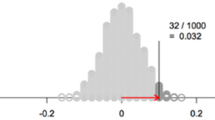Abstract
Current debates surrounding the virtues and shortcomings of randomization are symptomatic of a lack of appreciation of the fact that causation can be inferred by two distinct inference methods, each requiring its own, specific experimental design. There is a non-statistical type of inference associated with controlled experiments in basic biomedical research; and a statistical variety associated with randomized controlled trials in clinical research. I argue that the main difference between the two hinges on the satisfaction of the comparability requirement, which is in turn dictated by the nature of the objects of study, namely homogeneous or heterogeneous populations of biological systems. Among other things, this entails that the objection according to which randomized experiments fail to provide better evidence for causation because randomization cannot guarantee comparability is mistaken.

Similar content being viewed by others
Notes
“Determining whether there is a causal relationship between variables, A and B, requires that the variables covary, the presence of one variable preceding the other (e.g., A → B), and ruling out the presence of a third variable, C, which might mitigate the influence of A on B” (Leighton 2010, 622). Confounders are conceptualized as rival (usually causal) explanations of the observed difference in outcome between test and control. Thus, if the test and control systems differ in terms of factors that can impact on the measured outcome, the causal inference is deemed inconclusive since the possibility that something other than the manipulated factor may explain the difference in outcomes cannot be ruled out (Chow 2010).
The validity of extrapolations is also compromised. Heterogeneous populations and individuals drawn from these populations are no longer interchangeable experimental surrogates. If the individuals in a population differ in respect to confounding causal factors, causal claims established by studying individuals may not be representative of causal relationships prevalent in the general population, while causal relationships shown to be predominant in a population may not apply to a particular individual drawn from that population. In practical terms, this means that a treatment working well for a group of tested patients may turn out to have little impact in the general population, while a treatment generally successful in a population may not be effective for a particular patient.
The distinction between statistical (or chance) and causal explanations is discussed in Witteveen (forthcoming).
The example is adapted from Hill (1955, Ch. VIII).
References
Altman DG, Bland JM (1999) Treatment allocation in controlled trials: why randomise. BMJ 318:1209
Ankeny R, Leonelli S (2011) What’s so Special about Model Organisms? Stud Hist Philos Sci 42:313–323
Baetu TM (2016) The ‘Big Picture’: the problem of extrapolation in basic research. Br J Philos Sci 67(4):941–964
Burnham KP, Anderson DR (2002) Model selection and multimodel inference: a practical information-theoretic approach, 2nd edn. Springer, New York
Cartwright N (2010) What are randomised controlled trials food for? Philos Stud 147:59–70
Chalmers TC, Celano P, Sacks HS, Smith H (1983) Bias in treatment assignment in controlled clinical trials. N Engl J Med 309(22):1359–1361
Chow SL (2010) Experimental design. In: Salkind NJ (ed) Encyclopedia of research design, Sage. Thousand Oaks, CA
Clarke A, Fujimura J (1992) The right tools for the job: at work in twentieth century life sciences. Princeton University Press, Princeton
Feinstein AR (1983) An additional basic science for clinical medicine iii. the challenges of comparison and measurement. Ann Intern Med 99:705–712
Fisher RA (1947) The design ol experiments, 4th edn. Oliver and Boyd, Edinburgh
Godwin M, Ruhland L, Casson I, MacDonald S, Delva D, Birtwhistle R, Lam M, Seguin R (2003) Pragmatic controlled clinical trials in irimary care: the struggle between external and internal validity. BMC Med Res Methodol. https://doi.org/10.1186/471-2288-3-28
Hill AB (1952) The clinical trial. N Engl J Med 247:113–119
Hill AB (1955) Principles of medical statistics, 6th edn. Oxford University Press, New York
Howson C, Urbach P (2006) Scientific reasoning, a bayesian approach, 3rd edn. Open Court, Chicago
Kabisch M, Ruckes C, Seibert-Grafe M, Blettner M (2011) Randomized controlled trials: part 17 of a series on evaluation of scientific publications. Deutsches Ärzteblatt International 108(39):663–668
La Caze A (2013) Why randomised interventional studies. J Med Philos 38(4):352–368
Leighton JP (2010) Internal validity. In: Salkind NJ (ed) Encyclopedia of research design. Sage, Thousand Oaks
Lindley DV (1982) The role of randomization in inference. Philos Sci Assoc 2:431–446
Mill JS (1843) A system of logic, ratiocinative and inductive. John W. Parker, London
Müller-Wille S (2007) Hybrids, pure cultures, and pure lines: from nineteenth-century biology to twentieth-century genetics. Stud Hist Philos Biol Biomed Sci 38(4):796–806
Papineau D (1994) The virtues of randomization. Br J Philos Sci 45:437–450
Pearl J (2000) Causality, models, reasoning, and inference. Cambridge University Press, Cambridge
Saint-Mont U (2015) Randomization does not help much, comparability does. PLoS ONE 10(7):e0132102
Spirtes P, Glymour C, Scheines R (1993) Causation, prediction and search. Springer, New York
Steel D (2007) Across the boundaries: extrapolation in biology and social science. Oxford University Press, Oxford
The Cochrane Collaboration (2011) Cochrane handbook for systematic reviews of interventions Version 5.1.0 [updated March 2011]. In: Higgins JPT, Green S (eds) www.handbook.cochrane.org
Urbach P (1985) Randomization and the design of experiments. Philos Sci 52:256–273
Urbach P (1993) The value of randomization and control in clinical trials. Stat Med 12:1421–1431
Winch RF, Campbell DT (1969) Proof? No. Evidence? Yes. The significance of tests of significance. Am Sociol 4(2):140–143
Witteveen J (Forthcoming) Regression explanation and statistical autonomy. Biol Philos
Woodward J (2003) Making things happen: a theory of causal explanation. Oxford University Press, Oxford
Worrall J (2007a) Evidence in medicine and evidence-based medicine. Philos Compass 2(6):981–1022
Worrall J (2007b) Why there’s no cause to randomize. Br J Philos Sci 58:451–488
Author information
Authors and Affiliations
Corresponding author
Additional information
Publisher's Note
Springer Nature remains neutral with regard to jurisdictional claims in published maps and institutional affiliations.
Rights and permissions
About this article
Cite this article
Baetu, T.M. Causal inference in biomedical research. Biol Philos 35, 43 (2020). https://doi.org/10.1007/s10539-020-09760-4
Received:
Accepted:
Published:
DOI: https://doi.org/10.1007/s10539-020-09760-4




